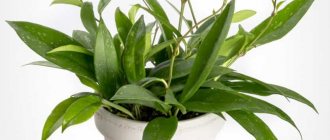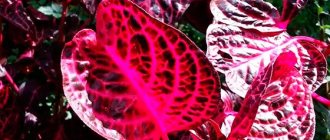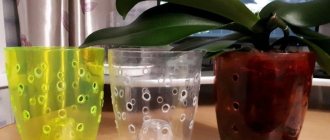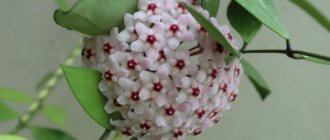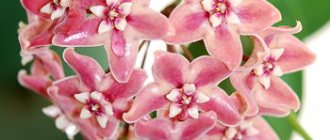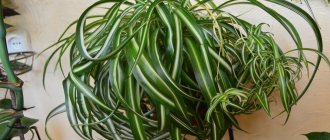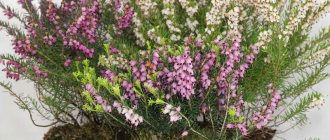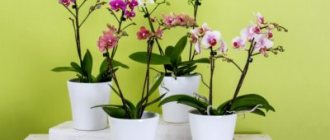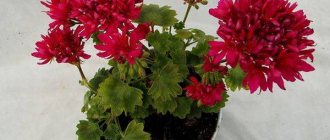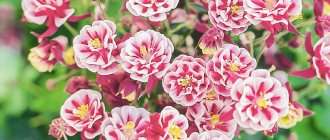Plants » Flowers
0
269
Article rating
Kira Stoletova
Decorative Hoya Carnosa is one of the most striking among the representatives of the Kutrovye family. The plant was named after its discoverer, Thomas Hoy, who was involved in growing flowers in greenhouses. Let's consider a detailed description of the species, its varieties and rules of care at home.
Hoya carnosa variegata
general characteristics
The second name is Hoya Fleshy; lat. Hoya carnosa.
This species can be distinguished from other varieties by several characteristics:
- has a massive, branched root system that quickly grows and fills the entire space in the pot;
- flowering occurs only after the roots have completely entwined the soil;
- the stem is curly, densely branched, the length can reach 10 m;
- the leaves are thick, fleshy, pointed at the tips, emerald green, size 8-9 cm;
- star-shaped flowers, consisting of five sharp petals, 2 cm in circumference, collected in umbrella inflorescences of 15-20 pieces.
- The color of the buds, depending on the variety, is red, snow-white, pink.
Blooms in early June and fades at the end of July. Repeated flowering begins in September. The blooming liana thins out a pleasant sweetish aroma.
The flowers are very decorative, they seem as if they are made of wax, which is why hoyas are also called wax ivy.
Signs and superstitions
This plant has a positive effect on the general condition of a person, so it can be grown in any room.
According to popular beliefs, the flower has a beneficial effect on the home atmosphere, enhances the harmony of worldview and improves family relationships, establishing connections between loved ones and relatives. It also normalizes sexual and psychological relationships between spouses.
Description
Hoya kerry is native to Polynesia and comes from the classic vine. Characteristics of the plant:
- heart-shaped leaf;
- tall shoots that require support;
- green color of foliage, but there are also variegated subspecies;
- leaves are dense, juicy, fleshy, not sinewy;
- minimum sheet size – 5 cm, maximum – 15 cm;
- flowering can be of various shades: red, white, pink and even yellow;
- the brighter the light, the richer the shade of the inflorescence;
- umbrella-type inflorescence, up to 2 cm in size;
- flowering has a pronounced aroma;
- nectar is secreted by mature plants.
Varieties
There are several attractive varieties that are adapted to home conditions.
Hoya fleshy
Tricolor
Fleshy hoya with decorative foliage - the main tone is red, the border is snow-white. As the leaves grow, they acquire a yellowish tint in the center.
Krimson Queen
It blooms with small pale pink flowers with a pale pink edge. The buds are collected in dense umbrellas.
The stems of the Crimson Queen variety are green, curly, the leaves are fleshy, glossy, and emerald green.
Compacta
Another unique decorative species with creeping stems densely covered with curly foliage. The color of the leaves is rich green, the surface is glossy.
It blooms with small flowers 2 cm in diameter, collected in dense umbrellas. The marginal petals on the buds are light pink, the crown is purple.
During the flowering phase, hoya thins out a pleasant honey smell.
Variegata *Variegata)
This variety is distinguished by variegated, curly foliage, densely covering the twisting stems. The leaf blade is fleshy, emerald in color, with a clear border of grayish, cream or white along the edge.
The shoots are purple and thin.
Suzi Q
This variety has curly, thin shoots, purple in color, and weakly leafy. The leaves are multi-colored - cream or beige with a lilac tint below, emerald on top with a thin white border along the edges.
Hoya carnosa tricolor
Gray Host
Translated from English it means a gray ghost. Liana-like hoya with brown, thin, curly shoots. Dense, fleshy leaves with a glossy surface develop along the entire length of the stems. The color is dark green with a grayish tint.
Crinkle
The stems are thick, purple in color, completely covered with fleshy foliage of an emerald hue.
The leaves grow in different directions - concave inward or outward, giving the plant a curly appearance. The flowers are pale pink, with a purple crown, collected in dense umbrella-shaped inflorescences of 20-25 pieces.
Exotica
A vine-like flower that can be grown with or without a support. It has decorative multi-colored foliage of lilac or light green tone with an emerald edging.
Unlike other varieties it grows very slowly - annual growth is 10-12 cm
Holliana
The leaves of this plant are bright green, shiny, develop in different directions, and densely cover the climbing stems. The edges of the leaf blade are cream.
Wilbur graves
An exotic variety with variegated foliage. The leaf blade is of medium length - 8-9 cm, width - 3-4 cm. The surface is smooth, emerald, covered with light green spots, specks and streaks.
Hoya carnosa care at home
In adult specimens, the leaflets are dominated by a light green tone with elements of a dark green tint.
Brazil
It is distinguished by its intensive growth - in a year the shoots can stretch up to 40 cm. The leaves are fleshy, 10 cm long. The main color is dark green with a silver coating.
The flowers are large - diameter 2.5-3 cm. Collected in loose inflorescences. The shape of the buds is in the form of bells in a beige shade, with a five-pointed burgundy crown located in the center.
Stardust
Translated from English it means “stardust”. A very beautiful evergreen vine with light brown, dense stems that form a branch of numerous shoots towards the tip.
Each branch is covered with leathery emerald-colored leaves with light green elements.
Main types
More than 200 species of hoya grow in the wild.
Did you know? The flower was named after the English gardener Thomas Hoy, who first began growing this plant indoors at the end of the 18th century.
Let's look at the main varieties that are grown indoors:
- Hoya carnosa variegata. This species differs from Hoya carnosa proper in its flowers. They are light pink with white trim.
- Hoya Kerry. It has large, fleshy, heart-shaped leaves that can be half the size of a person's palm. The color of the flowers is white with red. This species must be grown with support due to its large and heavy leaves.
- Hoya compacta. The leaves are twisted and resemble curls in appearance. The inflorescences are small and compact. This is where the name of the variety comes from. The color of the flowers is pale pink.
- Hoya lacunosa. The leaves of the plant are curved at the edges. They are dark green in color with small white dots all over their surface. The flowers are white, pubescent, with a small yellow or cream star in the center. This species has a very strong but pleasant aroma.
- Hoya linearis. The leaves are thin and look like long needles. Leaves with a gray tint, slightly pubescent. The flowers are white or cream with small hairs.
- Hoya multiflora. It differs from other species in that it grows in the form of a bush. The leaves are large, oval. The flowers resemble a pointed star in appearance. They are white with yellow tips. With proper care, this species can bloom all year round.
- Hoya obovata. The plant differs from other species by its large round leaves of bright green color with small pale spots. The flowers are light pink with a dark crimson star in the middle. Flowers are collected in cluster-shaped inflorescences of 30 pieces. Their scent is reminiscent of a rose.
- Hoya bella. The leaves are thin, long, and resemble a rounded arrowhead. The flowers are white, with a burgundy star in the center. They are collected in cluster-shaped inflorescences of 7–9 pieces.
- Hoya flavida . The leaves are oval, pale. A distinctive feature is the yellow color of the flowers with a small burgundy star. 767″ height=”402″[/img]
- Hoya carnosa tricolor. This species is very unusual in appearance. The leaves are milky white in the middle, bright green at the edges, with pink veins. Hence the name of the species. The flowers are light purple with a dark red center.
- Hoya retusa. The leaves are thin, elongated. They are heart-shaped at the end. The flowers are white with a purple center. This species has an original aroma, similar to the smell of lemon.
- Hoya polyneira. This species grows in the form of a bush. The leaves are shaped like a diamond. They have dark green veins. The outer star is milky, curved downwards. The inner star is burgundy. It can bloom all year long.
- Hoya caudata. Leaves are ovate. The flowers are white, fleecy, with a dark star in the middle.
Purchase and adaptation
You can buy one of the types described above in a specialized store. To get a healthy flower that will delight you with rapid growth and colorful flowering in the future, you need to carefully examine it.
Hoya carnosa compacta
The criteria for selecting a quality copy are as follows:
- stems of uniform color, without cracks, breaks, growths;
- the leaves are juicy, rich in color in accordance with the variety, do not contain yellow, black or brown spots or inclusions;
- the substrate is slightly moistened, without mold or acidification on the surface.
It’s better to buy flowering plants, so you’ll probably know that this is exactly the variety you need. In addition, a flower with inflorescences indicates the absence of health problems.
After the purchase, the hoya is placed in another room - a three-week quarantine will do her good. During this time, she will get used to home conditions, and you will be able to determine whether she has diseases or parasites.
Landing rules
To plant wax ivy, take not too tall pots made of ceramic or plastic with drainage holes. This is a liana-like crop, so it is better to use flower pots for growing.
The soil is fertile and loose - mix leaf soil, turf soil and humus in a ratio of 3:2:2. Many people plant in a ready-made store-bought substrate intended for indoor palm trees and orchids.
In the wild, the plant grows in sunny places, so at home it should be placed on a windowsill on the south or southeast side. At lunchtime, you will need protection from scorching rays so that the leaves and inflorescences do not get burned.
Description of varieties
The evergreen vine, which is known as Hoya fleshy, or wax ivy, has a well-developed root system and a branched stem up to 10 m long, covered with hard, pointed leaves. Flowering, during which fragrant flowers of various colors bloom, collected in umbrella inflorescences, occurs in the summer.
Breeders have developed many varieties of Hoya carnosa, which differ in shape, color of leaf blades and flowers.
Among the most common and original representatives of the type species are:
- Variegata - form with pink flowers bordered by a white stripe;
- Exotica - a distinctive feature of the variety is the yellow color of the leaf blades, gradually acquiring a green tint towards the edges;
- Tricolor - a variety with leaf blades edged with a green border, which change the main color from red to yellow as they mature;
- “Crimson Queen” - the variety stands out for its rich pink flowers with a more delicate border around the edges.
Home care
Despite its exotic nature, the indoor plant Hoya carnosa is not capricious, so caring for it will not cause any trouble for the gardener.
Soil composition and pot selection
When choosing a pot for a vine, you must remember that the hoya will not bloom until its roots completely entwine the earthen ball.
For this reason, preference should be given to small but tall pots or flowerpots if the gardener plans to grow the plant as a hanging plant.
A properly selected container is filled with loose, nutritious soil, which you can make yourself from leaf soil, turf soil, humus, sand in a ratio of 3:2:2:1.
It should be heated in the oven to destroy infection and insect larvae. You can also purchase the substrate in the store, choosing a soil mixture for palm trees.
Watering Hoya Carnose
The exotic flower should be watered sparingly after the earthen ball dries to the depth of the phalanx of the finger. In summer, weekly watering is enough for the vine.
With the arrival of winter, if the crop is kept in a room with a low temperature, the crop will need to be moistened only once every 2 to 3 weeks. Water procedures are carried out with settled water. In this case, it is necessary to ensure that water does not remain in the pan, which can lead to the development of gray rot.
Fertilizer application
The Hoya carnosa flower only needs additional nutrition every 2 weeks in the summer. For fertilizing, liquid mineral fertilizers for flowering plants with a high phosphorus content are used.
Planting and transplanting
The plant tolerates transplants painfully, so after purchasing a flower, you should give it time to acclimatize, and then carefully transplant it from the shipping container into a pot of similar diameter. A drainage layer must be placed at the bottom of the permanent container.
After planting, the hoya is not watered, but only sprayed
A drainage layer must be placed at the bottom of the permanent container. After planting, the hoya is not watered, but only sprayed.
Subsequently, replanting is carried out after 2 - 3 years, when the roots appear from the drainage holes, demonstrating that the pot has become too cramped.
Trimming
The flower does not need pruning, since new inflorescences appear on the old arrow. For sanitary purposes, only damaged leaves can be removed with a sterile instrument.
Features of reproduction
At home, Hoya is propagated by cuttings. The apical cuttings are cut 10–15 cm long so that they have 2 internodes. Hoya takes root both in water and in a moist substrate of peat and sand. If you create greenhouse conditions for the cutting by covering it with a plastic cap, the rooting process will speed up.
Plant diseases and pests
Like other succulents, the vine can be attacked by whiteflies, spider mites, mealybugs and scale insects.
To quickly and effectively deal with emerging pests, you should resort to spraying with an insecticidal preparation according to the manufacturer’s instructions.
The plant is not susceptible to diseases, but when water stagnates in the roots or when the soil is systematically waterlogged, gray rot may develop. To prevent disease of the graceful vine, the watering regime should be strictly observed.
The necessary conditions
For full growth, high-quality and long-lasting flowering of Hoya carnosa, several conditions must be provided
Hoya carnosa crimson queen
Humidity
This plant is from tropical countries, so it prefers to grow at high humidity - about 75-80%. This can be achieved by regularly spraying the crown with warm water. In spring and summer, the frequency is every three days. In the cold season, irrigate twice a month.
Sprinkling washes away dust, stimulates the growth of greenery and stems, and prevents the appearance of spider mites.
Temperature
Throughout the entire growing season - from spring to autumn, the temperature is suitable for the flower - within 23-27 ° C.
In winter, when the plant slows down, it is kept cool at 15-16°C.
It easily tolerates drafts, but cannot tolerate sudden changes in temperature, so when the room is ventilated in the cold season, it is moved to another place.
Illumination
A lack of light can negatively affect the general condition of Hoya carnosa - it begins to shed buds and foliage. The optimal duration of daylight hours is 8-10 hours throughout the year.
In spring and summer, the flower is placed in a place where there is diffused light in the morning and evening. In winter, they are illuminated with a fluorescent lamp - installed at a distance of 0.5 m from the crown.
Rules of care
All types of wax ivy require the same care - regular feeding, moisturizing and loosening.
Hoya carnosa variegata photo
Watering
This plant tolerates a lack of moisture more easily than its excess. Therefore, water abundantly, but only after the soil has dried to a depth of 4-5 cm. In spring and summer, the frequency is every seven days.
With the onset of autumn and throughout the winter, moisturize less frequently - once every 2-3 weeks. The water accumulated in the pan is drained to avoid rotting of the roots.
Use settled or filtered water at room temperature. The next day, the substrate is loosened superficially so that it does not form a crust and allows oxygen and moisture to pass through well.
Feeding
The exotic liana does not like overfeeding, so it should be fertilized only during the period of budding and flowering. Use mineral fertilizers alternately with organic matter. Store-bought preparations for feeding orchids and palm trees are suitable.
Apply once every three weeks in combination with watering to improve the quality of nutrient absorption and avoid burning the roots.
Trimming
Hoya carnosa does not tolerate this procedure well and may die, so it is not worth trimming the shoots and flower shoots on which new inflorescences will appear next year.
Only those parts that are dry, rotten, yellowed, or damaged by infections or parasites are cut out.
Transfer
After purchase, the plant is given time to adapt, then it is transplanted into a new pot 2-3 cm in diameter larger than the previous one. For replanting, take fresh and disinfected soil mixture.
A blooming hoya should not be disturbed, as it may not tolerate stress and will die. You need to wait until the inflorescences dry out. The procedure is carried out using the method of transferring an earthen clod.
House flowers also need to be replanted - once every three years, replacing the old soil with a new one. It is important not to damage the delicate root system, as it will quickly disappear and the hoya will wither.
Sick plants whose roots have rotted are replanted. First, water it, then pull it out of the flowerpot, wash off all the soil, cut out non-viable roots, and dip it in a fungicide solution for half an hour. Dry and plant in a new pot with a sterile substrate.
Rules for caring for Hoya at home
Each hoya, depending on the species, requires its own conditions for maintenance. Common to all types of wax ivy is control over soil moisture. The formation of dirt in a pot has a detrimental effect on any hoya, even the most unpretentious one.
Flower growers conditionally divide hoyas into categories based on moisture consumption and light requirements:
- Hoyas with hard leaves, like succulents - fleshy and Kerry hoyas. An excellent location for these flowers is a south window, where there is plenty of sunlight. Watering is done as the soil dries;
- Plant varieties with thin leaves (for example, Hoya multiflorum) love moist soil and do not tolerate direct sunlight. They need shading and location on a western or eastern window;
- Hoyas with pubescent leaves of light green color (Hoya lineara, de Seren, etc.), grow well in moist soil with sufficient sunlight;
- Hoyas with pubescent leaves of dark green color (serpentine and Hoya Thompson), prefer shaded areas of the windowsill and require regular watering.
For your information! For all species, the optimal temperature is in the summer from 15 °C to 25 °C, and in winter from 15 °C. Some plants tolerate temperatures up to 10 °C well. Otherwise, it is necessary to additionally warm the air in the room. You should not experiment, since, for example, Hoya Bella may lose leaves from the cold.
Hoya Compacta
Plants growing at home do not fall into a pronounced dormant period. You can notice that the plant is in a semi-dormant state by slowing growth. During this period, it is recommended to abandon fertilizing and reduce the amount of watering. The plant must rest. A period of incomplete dormancy occurs in indoor flowers when daylight hours shorten. Turning on the lighting in the evening and, accordingly, extending the daylight hours will shorten the rest period.
Fertilizing and replanting the plant
There are about two hundred species in nature. They all require different types of fertilizers as they grow in different regions in the wild. Experienced gardeners have found that the best fertilizer for all types of wax ivy is succulent fertilizer. Hoyas also respond well when replanted regularly in fresh soil. At the same time, fertilizing is not applied so often.
It is recommended to replant young plants every year in the spring. Adults require a transplant once every 2-3 years if necessary. Hoyas do not require large pots to grow
But it is important to remember that with each transplant the plant requires a new container, and not after other flowers
The selected soil mixture for indoor vines must be sterilized. Select a mixture for transplantation with good air permeability and a neutral or slightly acidic pH.
Excellent composition - humus, leaf soil in equal parts and twice as much clay-turf soil. Some varieties do well in orchid substrates.
Drainage is placed at the bottom of the pot, and replanting is carried out using the transshipment method (without destroying the earthen clod).
Note! Hoya propagation occurs in the spring by cuttings
Pests and diseases
In the wild, wax ivy is highly resistant to various pests and diseases. But at home, if poorly cared for, Hoya can be affected by scale insects, aphids or red spider mites. Special insecticides are used to control pests.
Preventing the development of nematodes in a potted plant is achieved by sterilizing the soil before replanting.
Reproduction methods
Hoya can be propagated in several ways at home - if all the rules are followed, each gives a positive result.
Hoya carnosa gray host
Cuttings
Planting material is cut in spring or summer during the active growth phase. Choose strong stems without signs of disease infection or mechanical damage. Segments 15-20 cm long with several leaves and buds are cut off. In the lower part, remove all the foliage and immerse it in Kornevin’s solution for an hour.
The shoots are planted in a loose peat-sand mixture (1:1) to a depth of 2-3 cm, moistened, exposed to light and kept at a temperature of 22-25°C.
To help the seedlings take root faster, water regularly. After about 2-3 weeks, they will begin to develop new leaves - a sign that they have taken root. They are grown for another month, then planted in separate pots.
Leaf
Several leaves with an axillary bud are separated from the stem. Dip for 10 minutes in a solution of Kornevin or Heteroauxin. Planted in a mixture of peat and sand mixed in equal quantities. Water with warm water and cover with film.
The mini-greenhouse is ventilated every day and moistened as the substrate dries. After about 2 weeks, the leaves will sprout their first roots, but they can be planted only after the stems appear. It will take 1.5-2 years for the shoots to develop.
Stem layering
Another effective propagation method, which is used for adult plants over 5 years old.
Select the strongest and most flexible shoot, make a 1-1.5 cm long incision on it. Wrap it in damp moss, then cover it with film.
As soon as the first roots break through the moss, the shelter is removed, the stem is separated from the mother flower, and planted in a peat-sand mixture.
Reproduction
The plant is propagated using cuttings and seeds. Let's look at each method in more detail.
Video: hoya propagation
Cuttings
For this, apical cuttings are used, which are cut at a level of 10–15 cm from the top. There should be several buds on the cutting. To root a new plant, plant it in peat mixed with sand in a 1:1 ratio. Moisten the soil. Keep the pot with the planted cuttings in a very warm place.
Important! The higher the room temperature, the faster the cutting will take root.
Another way is to place the cutting in water and place it in a warm place. In about two weeks, roots will appear. Having noticed them, the cuttings are immediately planted in the soil.
Growing from seeds
Hoya seeds resemble dandelion seeds. They need to be collected from flowers and dried. After this, the seeds are planted in the same soil as the cuttings. To ensure that the seeds germinate quickly, place the pot with them in a warm place. Water the soil regularly as soon as the top layer dries out. At the same time, avoid overmoistening the substrate.
After 3 months, healthy plants are selected from all seedlings and planted in a separate container. You can also sow seeds in moistened sphagnum moss, wrapped in a nylon mesh and placed in a warm place. In this case, the seeds will sprout faster. As soon as they germinate, the small plants are planted in a pot along with the moss.
Diseases and pests
Throughout the year, this indoor flower can be damaged by various infections and parasites. The main reason is violation of the rules of care and maintenance. If detected early, the plant can be saved.
| Diseases and pests | Symptoms | Treatment methods | Prevention |
| Spider mite | The microscopic insect feeds on the juice of leaves and buds, and entwines the lower part of the shoots and leaves with a small cobweb. Damaged areas become deformed, wrinkle, turn yellow and dry out | At the initial stage of infection, wash with soap suds or a solution of laundry soap (40 g per 1 liter of water). The advanced stage is treated with acaricides - Actellik or Aktara | Increase humidity, lower temperature, regularly irrigate the crown, especially on hot days |
| Aphid | It settles in colonies on the underside of leaves, reproduces en masse, loves to feast on the juice of young leaves, buds, and shoots. Damaged organs turn yellow, curl and crumble | If the flower is not neglected, it is treated with an infusion based on tobacco, orange peels or a soap solution. Severely affected specimens are sprayed with chemicals - Karbofos, Fitoverm or Aktara | Buy healthy plants, keep them in quarantine, regularly loosen the soil and inspect the crown for pests. |
| Mealybug | A whitish coating on the surface of the leaves is the first sign of infection. Small white parasites feed on the tissues of leaves and buds, as a result of which they turn black and die. Can also parasitize roots | Such a plant must be urgently removed and all damaged parts on the roots and crown must be cut out. Immerse the root system in the fungicide solution for 2 hours, then dry and transplant into a new pot with sterile soil mixture. Additionally spray with Fitoverm or Fundazol | Use disinfected soil for planting and replanting, avoid overwatering and promptly trim rotten, yellowed twigs and leaves |
| Shchitovka | You can identify it by reddish or brown growths in the form of plaques on leaves and stems. The insect sucks out the juices, in the affected areas the plant turns black and dies | Remove non-viable organs, treat with Decis twice with an interval of 7 days | Regularly trim dried, rotten branches, periodically loosen the substrate, buy healthy plants, water and feed on time |
| Powdery mildew | A whitish coating on the surface of all parts is a sure sign of a fungal infection. Over time, the damaged areas darken, become covered with condensation and rot. | Cut out questionable leaves and shoots, treat the crown and soil with Skor, Hom or a solution of colloidal sulfur | Before purchasing, carefully inspect the flowers, keep them in quarantine, regularly replant them in sterile and fertile soil, avoid overwatering |
| Root rot | This disease affects vines that are often overwatered with cold water. The root becomes overcooled and begins to rot. Later, the rot spreads to the stems - they become watery, soft, and darken. | The plant is pulled out of the pot; if the root system is completely rotten, it is disposed of; first, I cut off several cuttings or leaves for rooting. If the damage is minor, cut out the rotten roots to healthy tissue, dip them in a fungicide solution for an hour, dry them and replant them in a new pot with a disinfected substrate. | Avoid overwatering, use warm water for irrigation |
Growing difficulties: mistakes leading to disease
Hoyas kept in suitable conditions and receiving proper care, as a rule, do not get sick. Only weakened specimens are prone to illness and are unable to resist pests:
- If there is a lack of water, a flower may develop a mealybug - the first sign of infection, the appearance of a whitish coating. You can remove it by treating the foliage with a soapy solution and increasing the air humidity in the room.
- In the heat, when the air is too dry and the temperature is high, spider mites can appear on the hoya, entangling the flower with a thin web. This “guest” is brought out in the same way as the previous one, with mandatory correction of the microclimate.
- Excessive waterlogging of the soil leads to the development of root rot. This often turns out to be the cause of death of the vine, since external signs of the disease appear too late. If you still manage to recognize the disease at an early stage, then you can save the plant by washing the roots in water and cutting off the affected areas. They should be disinfected and the hoya should be planted in fresh soil.
